Grinning From Earbud to Earbud Making Musicians Happy with In-Ear Monitors
By Ron Simonson
If you’ve ever been tempted to turn off your housespeakers just to show your musicians how much sound their wedge monitors produce, you’re probably already excited about in-ear monitor (IEM) systems.
IEMs can eliminate all the monitor sound that muddies up your house mix, often helping musicians play more "tightly" with each other, and thereby enabling better worship — which is, after all, the purpose of your investment in your entire sound system.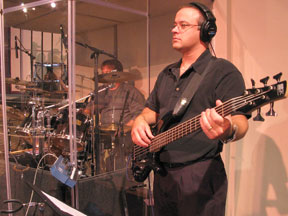
However, you won’t be able to realize the promise of IEMs without answering the needs of your musicians; often, easier said than done. IEMs change the way musicians interact with sound — from an ambient experience where they can converse with the band, hear audience response, and feel low-frequency sound waves, to an experience that exists exclusively and quite literally between their own ears.
Because the shift is so personal — and because every musician’s needs are individual — there is no "one size fits all" approach to IEM systems, and, unfortunately, it’s very easy to turn musicians off to IEMs altogether if they’re not satisfied early on.
As a result, while IEMs may clean up the house mix, the quality of the group’s music may suffer when individual musicians don’t hear — or even feel — the sound they need to contribute their parts effectively.
OFFERING "MORE OF ME"
As most sound engineers will attest, the first challenge in any monitoring system is to give the individual musicians enough of their own signals – i.e., giving each musician more of "me". In the world of wedge monitors, you can get away with daisy-chaining several monitors on the same channel.
Not so when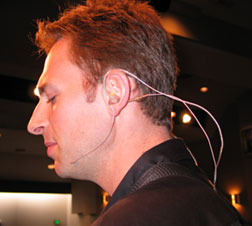 the musicians’ ears are plugged with tiny earphones that are responsible for delivering all the sound the musicians hear. To give more "me" to each musician on the platform, you’ll need to create a separate mix for each person, which will be an added burden to the sound engineer unless you adequately address the "control" challenge described below.
the musicians’ ears are plugged with tiny earphones that are responsible for delivering all the sound the musicians hear. To give more "me" to each musician on the platform, you’ll need to create a separate mix for each person, which will be an added burden to the sound engineer unless you adequately address the "control" challenge described below.
Wireless IEM systems are more desirable because they are usually less cumbersome and allow greater mobility on stage. However, the sheer expense of wireless given the number of required channels can quickly eat through the entire IEM budget, and depending on the system and where you place the transmitter, you may encounter RF dropout on the platform. As a result, you should carefully balance the number of wireless channels for each individual musician — such as wireless for the worship leader and lead guitarist, and supplement with wired systems for stationary musicians like drummers and keyboardists — for maximum cost-effectiveness.
MAKING SURE IT SOUNDS AND FEELS GOOD
Even though wedge monitors spell trouble for the audience, not to mention the fact that they drown each other out as every musician tries to hear "more of me," wedge monitors are comfortable and intuitive to use.
That is, wedge monitors are remotely positioned on a floor or a stand — not physically attached to the musician. They mix with the ambient noise of the room, allowing musicians to communicate with each other and hear the house responding. They produce high and low-end frequencies, and the bass line creates a soundwave that impacts musicians viscerally.
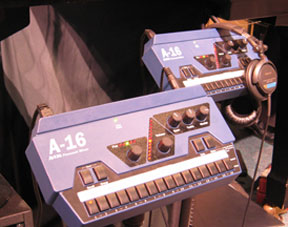 The closer you can get the IEM system to replicate the intuitive, comfortable aspects of wedge monitors, the more likely your musicians will accept it.
The closer you can get the IEM system to replicate the intuitive, comfortable aspects of wedge monitors, the more likely your musicians will accept it.
START WITH YOUR SIGNAL
Any minor problems with your sound will be intensified by several orders of magnitude as the signal passes through a series of direct or auxiliary outputs from the source to your musician’s ears, especially when that IEM signal is all the musician hears. Tonal problems on individual mics or instruments,often unnoticed in the din produced by wedges, are unacceptable when inserted directly into a musician’s ear. Equalization and compression for each input channel, as well as for each IEM channel, are highly effective in producing a clean, clear IEM feed that musicians will embrace. Professional touring audio engineers use dedicated IEM digital processors to cleanup the signal before it reaches the artist. They also use dedicated on-stage monitor mixers to provide a clean, direct and properly tone-balanced signal. If you just patch your IEM transmitter into a direct out on an old house console, chances are the musicians will blame the quality problems on the new in-ear system and may want to throw the earphones out the first time they use them. Assure your musicians that you are sensitive to their needs and will continue to work with them until they are getting the signal they need to create great music.
BE KIND TO THEIR EARS
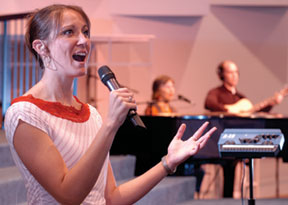 On the flip side, the new system may indeed be the problem if you’re using ear buds that don’t deliver enough dynamic range. Before you invest in an IEM system be sure to consult with an expert in selecting the best ear buds — someone who will take the time to understand your specific goals and total budget, and then recommend individual solutions for each musician on the platform. If possible, use dual driver earphones for a smooth and articulate sound. Just like house and monitor speakers, the quality of your transducer makes all the difference in the quality of your result. Poor quality earphones will defeat your efforts the first time your musicians plug them into their ears.
On the flip side, the new system may indeed be the problem if you’re using ear buds that don’t deliver enough dynamic range. Before you invest in an IEM system be sure to consult with an expert in selecting the best ear buds — someone who will take the time to understand your specific goals and total budget, and then recommend individual solutions for each musician on the platform. If possible, use dual driver earphones for a smooth and articulate sound. Just like house and monitor speakers, the quality of your transducer makes all the difference in the quality of your result. Poor quality earphones will defeat your efforts the first time your musicians plug them into their ears.
HELP THEM FEEL THE GROOVE
Musicians keep time with their bodies, not their minds. If your rhythm players can’t feel the beat, they won’t use the IEM system. Since drummers and bass players usually need to feel the music to stay in time with each other, supplement their IEM’s with tactile transducers that produce low frequency response into their drum or  keyboard throne. Bass players love to play on a platform equipped with a tactile transducer. You’ll have a couple of unused powered monitors ends once you’re using IEM’s, so the expense of adding tactile transducers is minimal. Make sure you properly high and low-pass the feed to the tactiles, or they’ll burn out during the first service.
keyboard throne. Bass players love to play on a platform equipped with a tactile transducer. You’ll have a couple of unused powered monitors ends once you’re using IEM’s, so the expense of adding tactile transducers is minimal. Make sure you properly high and low-pass the feed to the tactiles, or they’ll burn out during the first service.
ONE SIZE DOES NOT FIT ALL
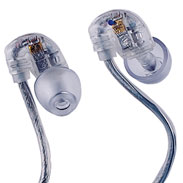 Different ear bud styles will fit your musicians more or less comfortably, depending on the individual. Audiologists can offer custom earbuds created from a mold — just like a custom hearing aid — which are especially handy for hard-to-fit ears. Just take your transducer and plug it into the mold for the ultimate custom fit! Try to avoid the yellow foam earpieces for long term use. Of course, some of your musicians will be happiest with just a high-quality set of headphones.
Different ear bud styles will fit your musicians more or less comfortably, depending on the individual. Audiologists can offer custom earbuds created from a mold — just like a custom hearing aid — which are especially handy for hard-to-fit ears. Just take your transducer and plug it into the mold for the ultimate custom fit! Try to avoid the yellow foam earpieces for long term use. Of course, some of your musicians will be happiest with just a high-quality set of headphones.
MAKE ROOM FOR ROOM SOUND
You’ll want at least a couple of mics positioned to pick up musician conversations on the platform, as well as the sound of the house. Ambient sound in the monitor mix will help musicians feel like their ears are still connected to the world around them — but adding too much "noise" defeats the purpose of monitoring.You will need to experiment to find the best overall position for ambient mics in your room.
GIVING MUSICIANS A SENSE OF CONTROL
The final challenge in IEM systems is giving musicians adequate control over everything they hear, for their sake and yours! 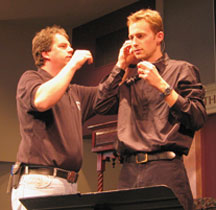 There’s nothing worse than having 10 people on the platform yelling "more of me!", a situation that intensifies when you replace wedge monitors and ambient sound with IEMs or headphones.
There’s nothing worse than having 10 people on the platform yelling "more of me!", a situation that intensifies when you replace wedge monitors and ambient sound with IEMs or headphones.
Many churches solve this problem by locating a dedicated monitor mixer at the platform and staffing it with a monitor technician who can deal with the musicians’ requests. The tech can plug into any given musician’s feed and adjust their signal on the spot, especially helpful when a musician’s request for “more of me” actually translates into "less of something else."
Even if you don’t have an on-stage monitor mix, you’ll score big points by providing musicians with a contact person directly on the platform and your front-of-house people will be equally delighted to offload responsibility for handling monitor requests at the same time they are trying to develop a house mix!